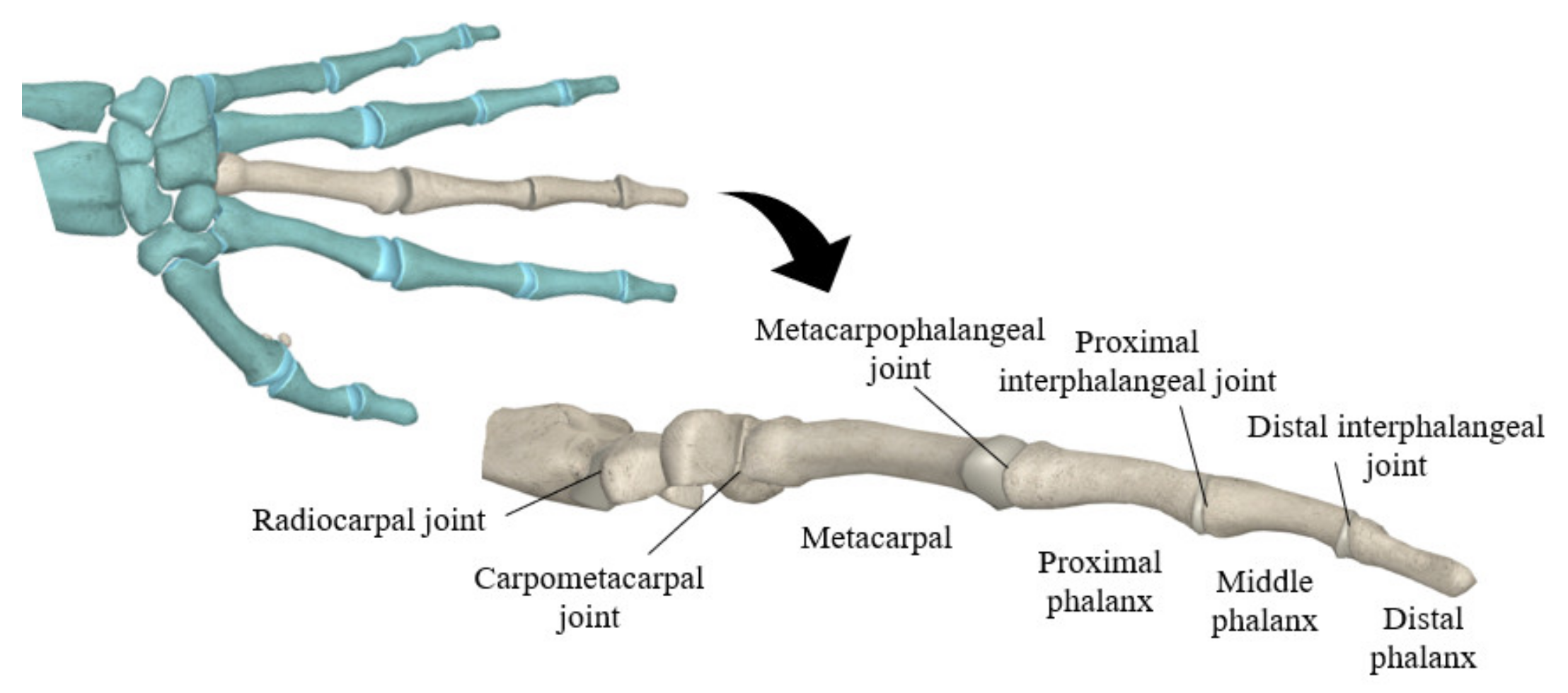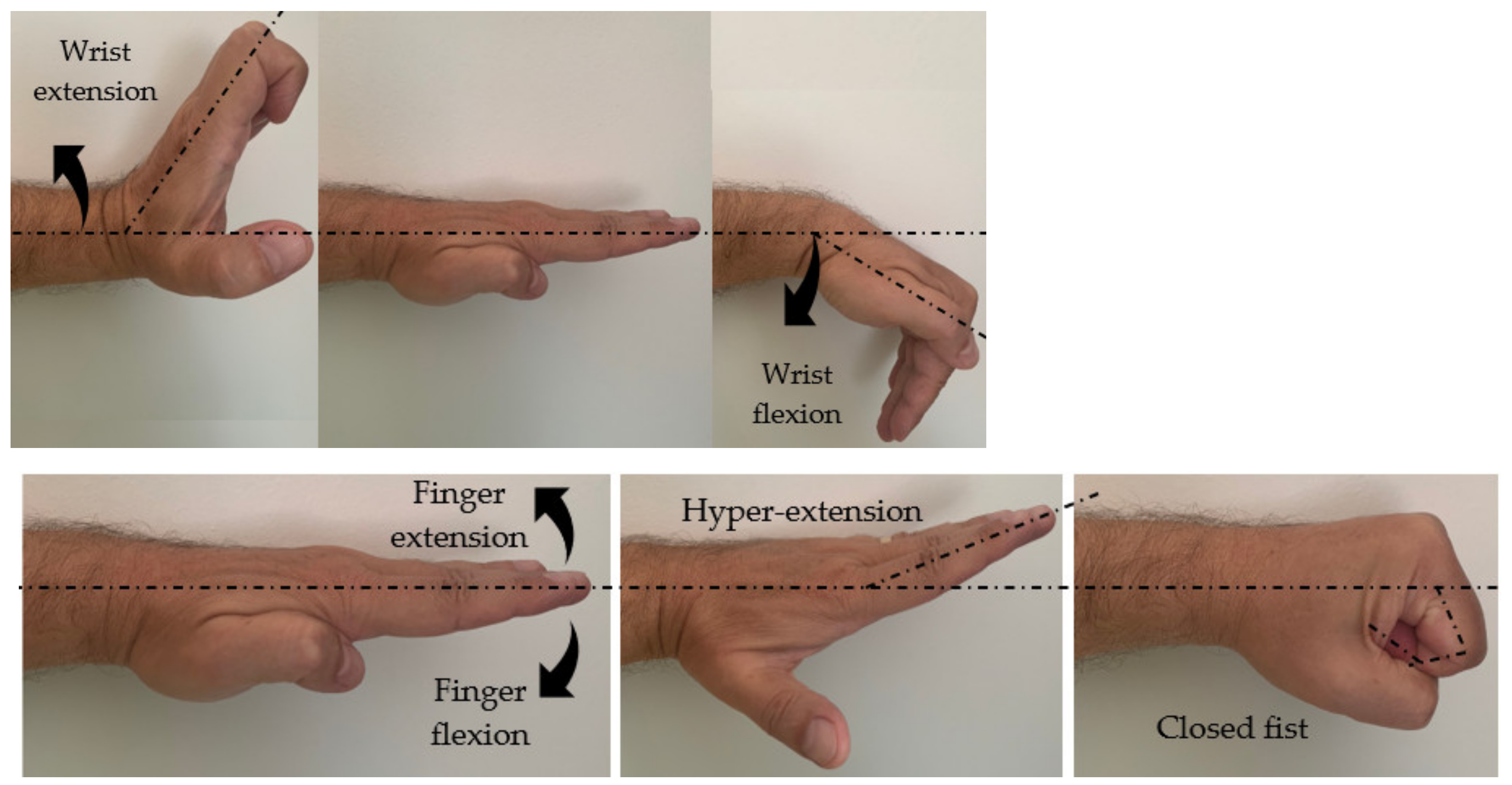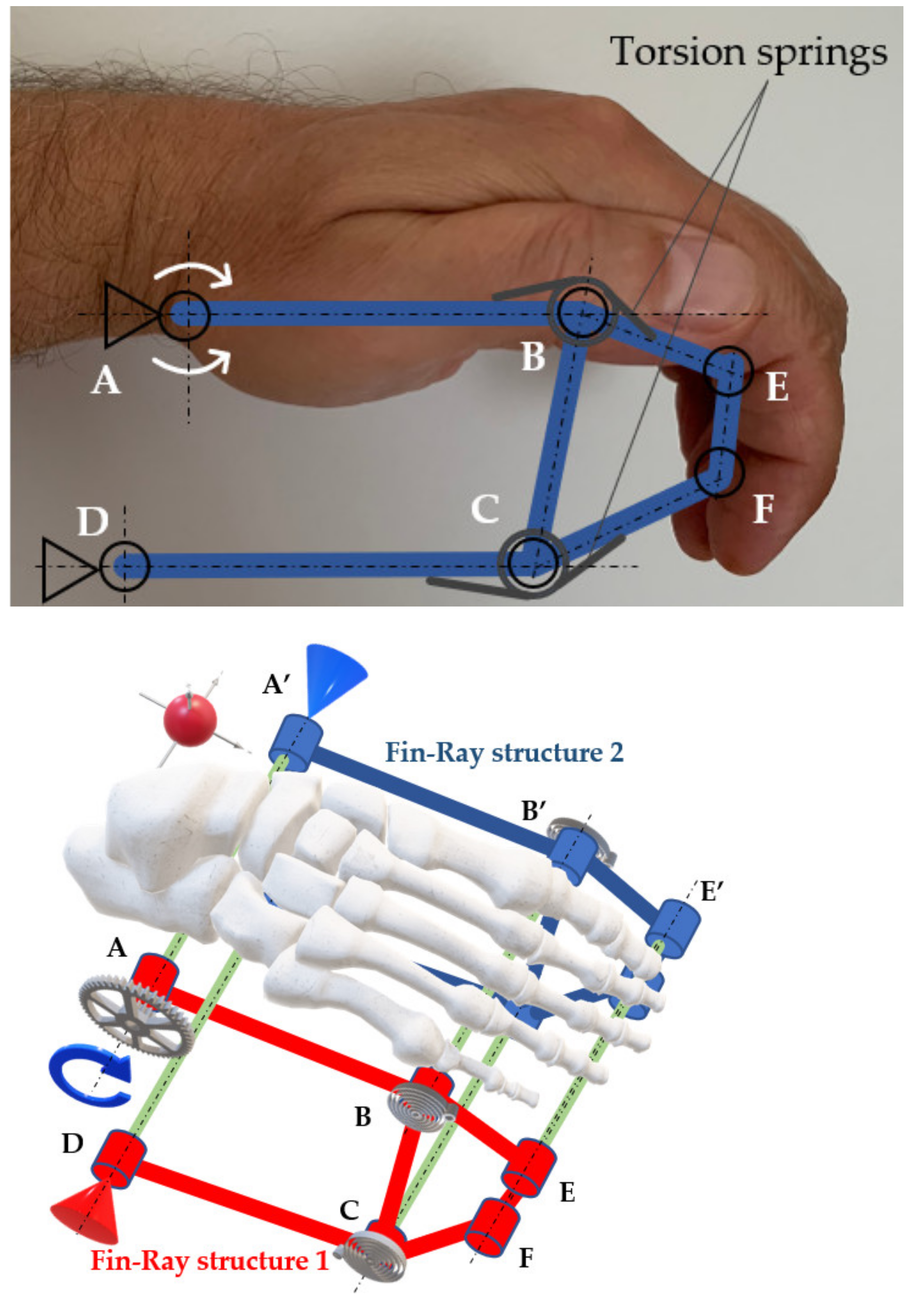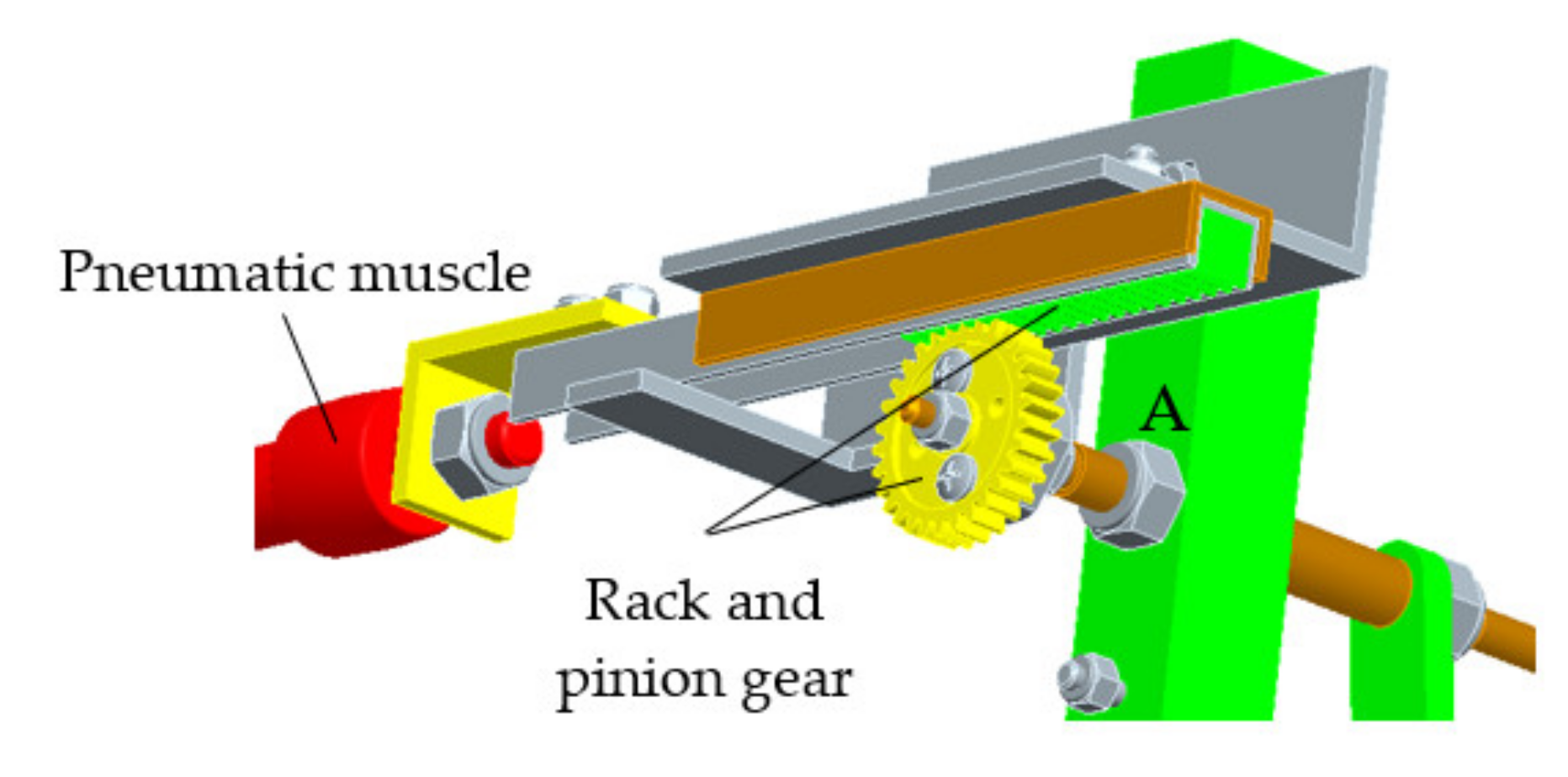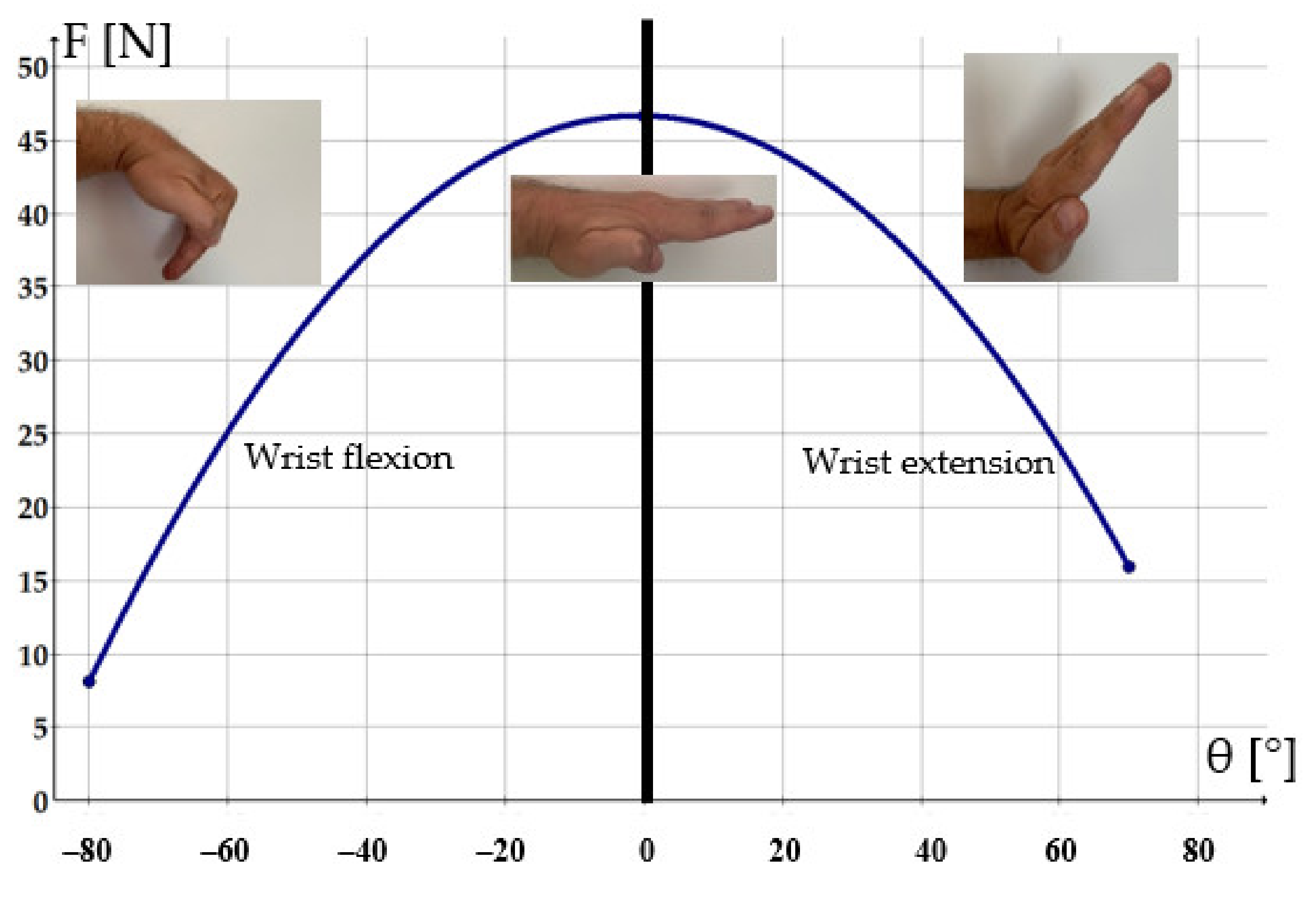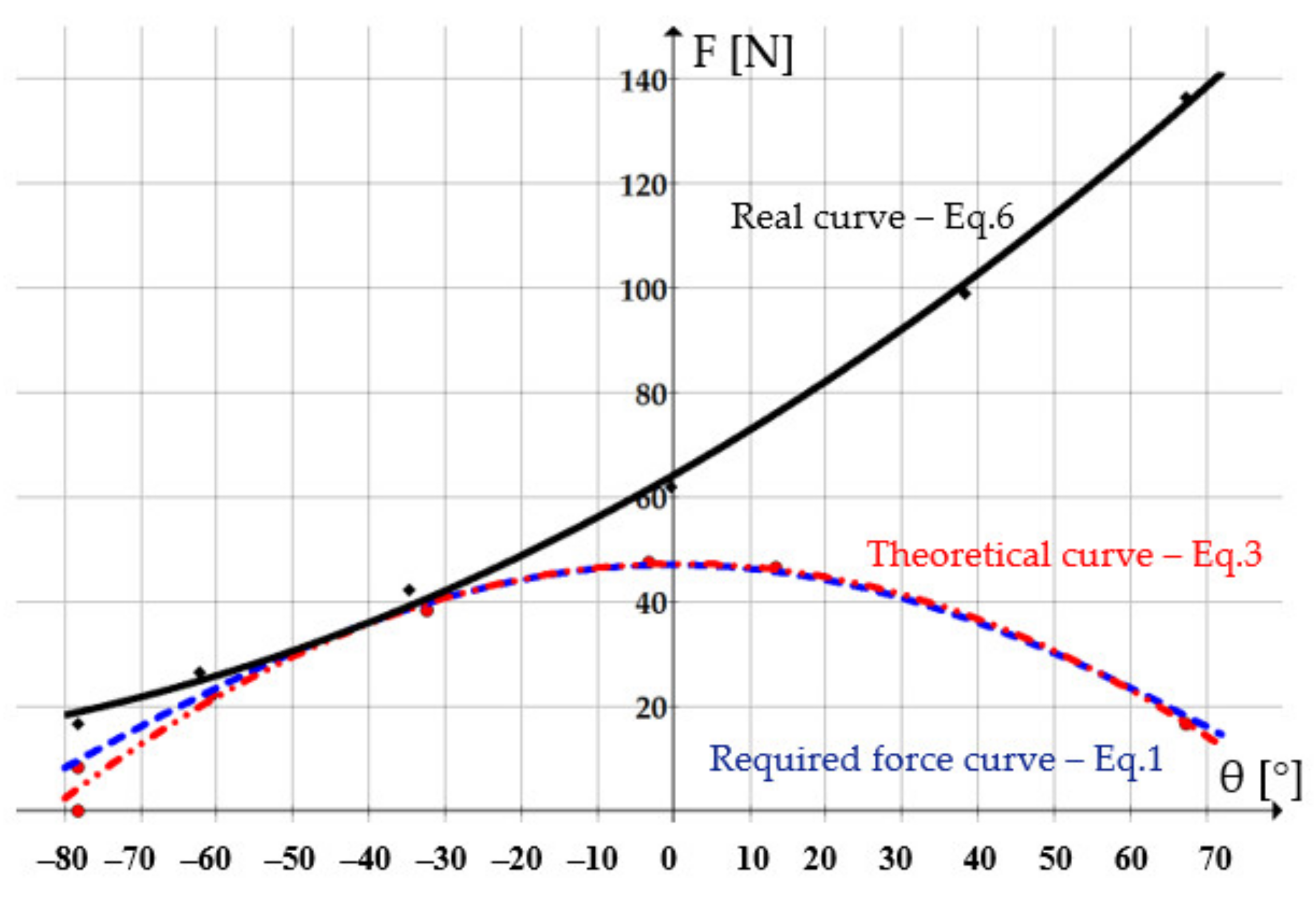1. Introduction
The hand, with its 27 bones of the palm skeleton and the fingers, qualifies as the most complicated osteoarticular segment of the human body. This most complex articulation includes the 8 carpal bones displayed in two transversal rows forming the wrist, the 5 metacarpal bones, followed by the 14 phalanxes of the fingers. Obviously a bone system of such complexity is more susceptible to trauma that would inhibit the functions of the hand. Gripping, discriminatory sensitivity, expressivity, and conducting professional tasks can be thus hindered or even cancelled.
Any partial or total impairment of the hand is a professional and social emergency that calls for therapeutical methods able to accelerate the recovery of the affected joint. Adequate medical treatment of the effects of trauma sustained by joints of the hand is typically followed by immobilization in a gypsum cast. However, extended repose of the joints leads to muscle hypertrophy or even atrophy, to bone demineralization and dysfunctions of the circulatory apparatus. Consequently, in order to prevent the negative effects of immobilization passive kinesiotherapy or excitomotor therapy (the latter in cases of muscle atrophy by denervation) are used [
1,
2,
3]. These techniques are part of the general approach to swift patient rehabilitation and thus favor a high functional recovery rate and early return to work life.
Motion-based rehabilitation of the hand depends of the location of the trauma and the type of the already applied (surgical or nonsurgical) treatment. The rehabilitation protocols are aimed mainly at pain control and restoring the functionality of the affected area. Such protocols need to be adapted to patients’ motor state (muscle tone), sensitivity state (proprioception), and last but not least to their psycho–social and occupational state.
The functional reeducation program needs to be initiated approximately 3 days after the trauma has been treated. In order to avoid excessive local straining, the use of customized orthoses is recommended, as well as light physical exercises that consist of compression/elevation active and passive mobilization of the fingers [
4].
Subsequently to this stage continuous passive motion (CPM) is applied. This entails the mechanical mobilization of the affected joint without straining the patient’s muscles. These motions are designed to impede the generation of fibrous tissue and to reduce joint rigidity. CPM is performed by means of specially conceived equipment that is capable of applying customized optimum rehabilitation motions to the joint.
The passive mobilization of the hand joints by means of rehabilitation equipment requires controlling the various parameters of the motion, like the amplitude and speed of the motion and duration and frequency of the exercises. Not to be neglected is the magnitude of the applied forces such as to ensure pain-free rehabilitation exercising. CPM rehabilitation equipment need to allow the adjustment of the quantities mentioned above so that rehabilitation exercises can be adapted to the clinical state of the patient.
At present the rehabilitation of the hand joints is performed with the help of equipment the majority of that is actuated electrically. Thus the 6000 Hand CPM OrthoAgility
® is used for postfracture recovery, reconstructive surgery on bone, cartilage, tendons, and ligaments, and allows patients to achieve a full composite fist of 270° [
5]. Another often-deployed piece of equipment is the Kinetec—8091 Portable Hand CPM designed for rehabilitation after prosthetic replacement of the MCP (MetaCarpoPhalangeal), PIP (Proximal InterPhalangeal) and DIP (Distal InterPhalangeal) joints, and related to rheumatoid/neurological or afterburn stiffness [
6].
Designed for postoperative rehabilitation, the Kinetec Maestra™ CPM is yet another device that provides a rehabilitation solution for wrist pathology, allowing the achievement of a full composite fist de 255° [
7]. The WaveFlex Hand system developed by Remington Medical is a light construction deployable both in hospital and in patients’ homes. It supports the performing of rehabilitation exercises within the limits of hand joint biomechanics [
8].
Recovery of hand joints is also conducted by means of a system with 3 degree-of-freedom that can be attached on a MIT-MANUS robot. This piece of equipment limits motion to 60°/60° in flexion/extension, 30°/45° in abduction/adduction, and 70°/70° in pronation/supination [
9].
Besides CPM-based rehabilitation literature also discusses game therapy for poststroke recovery of upper limbs. Thus, motor-training software on tablets or smartphones offer a low-cost, widely-available solution to supplement arm physiotherapy after stroke. Studies involving 127 therapists revealed that the most commonly used device was Nintendo Wii. Gaming was reported to be enjoyable but therapists described barriers, which relate to time, space and cost [
10,
11,
12].
This category of game therapy includes also a smart mobile device for the assessment and training of hand functions called GripAble Device [
13], which is connected to a tablet by means of a dedicated software application. Its deployment is not based on CPM, as the equipment is driven by the patients themselves, patients who have not suffered total mobility loss.
Given the benefits of soft robotics several research teams have developed variants of wearable orthotic devices for the rehabilitation of the hand. Known are for example the Exo-Glove PM—a customizable modularized pneumatic assistive glove [
14] or the Harvard Soft Robotic Glove for Neuromuscular Rehabilitation developed by researchers of the Wyss Institute at Harvard University [
15]. In both cases the soft actuators are mobilized by compressed air.
During rehabilitation exercising motion can often exceed the limits of patient supportability with the consequence of onsetting pain. The system’s response time since the moment of pain onset needs to be as small as possible and thus is an essential characteristic of any rehabilitation equipment. While the electrically actuated systems described above do have such a self-adaptive behavior, this is made possible only be excessive sensorization and complicated control diagrams, all of this leading to cost-intensive rehabilitation equipment.
Rethinking their construction makes it possible to reduce the cost of rehabilitation equipment. By eliminating many of the sensors, simplifying control diagrams and most importantly by using adjustable compliance actuators (ACAs) performant equipment can be developed at significantly lesser costs. An example of adjustable compliance actuator is the pneumatic muscle whose inherently compliant behavior is due to air compressibility. Characteristics of pneumatic muscles are safe interaction with human operators and their ability of storing and releasing energy into passive elastic elements [
16].
Conception of pneumatic muscle actuated rehabilitation equipment for hand joints is still in its incipient stage as to date merely few published patents are known and just a small number of prototypes or functional equipment. One such piece of equipment is the Hand Mentor Pro (manufactured by Motus Nova) actuated by a pneumatic muscle. The Hand Mentor is a stroke rehabilitation device that provides active assistance. It moves the patient like a skilled physical therapist, and is designed for recovering the gripping ability of the hand [
17].
Another example of rehabilitation equipment is the EXOWRIST, using four pneumatic muscle actuators to undertake the 2-degrees-of-freedom movements performed by the human wrist. It is characterized by adjustable performance to meet the needs of individualized configuration, assisted movement capabilities, high reliability in different treatment environments and conditions for safe human–robot interactions, low development and construction costs, and high portability for autonomous and independent use [
18].
Starting from the current state of available rehabilitation equipment for the joints of the hand and given the necessity of further developing such light, portable, affordable, and reliable systems benefitting from a compliant behavior this paper pots forward a novel constructive solution able to mobilize simultaneously both wrist and finger joints. The joints of the hand are set into motion by a pneumatic muscle, and the novel concept of the palm support is based on the Fin-Ray effect, bioinspired from the fins of fish.
The structure of the paper includes a second section that describes the biomechanics of the hand joints and defines the limits of their motions. These are the input data used for the concept of the novel rehabilitation system. The third section of the paper presents the bioinspired elements that determine the concept of the equipment, as well as its functional principle and construction. The fourth section presents the experimental results and the last section is dedicated to the conclusions of the discussed study.
2. Biomechanics of the Hand Joints
The construction of this type of rehabilitation equipment is based on detailed knowledge of the anatomy of the hand and of the motions its joints are capable of conducting. Further necessary data are the limits to such motions and the generated forces and moments.
Figure 1 details the main bones and joints of the hand skeleton [
19]:
The lengths of the metacarpal bones and of the phalanxes factor in significantly when conceiving rehabilitation equipment for the hand. Depending on gender, age, and body size the lengths of the bone segments differ, hence the dimensions of a system designed for the rehabilitation of the hand can be established on grounds of statistical studies or based on atlases of human measurements.
Z. Ma and P. Ben-Tzvi present in [
20] a statistical analysis based on measurement data of the hand bone lengths. They assert that the distances between the interphalangeal joints separating the distal, middle, proximal and metacarpal phalanxes, respectively, represent an 18; 26; 44; 70 Fibonacci sequence. Each number of such sequence is the sum of the preceding two (x
n = x
n−1 + x
n−2). Based on this finding
Figure 2 shows the dimensions of the middle finger used as reference for the construction of the rehabilitation equipment discussed in the paper.
Various studies related to the biomechanics of the hand joints highlight the essential motions to be reproduced by rehabilitation systems. These are the flexion/extension of the wrist (the radiocarpal joint) and of the joints of the fingers (
Figure 3) [
21,
22].
The flexion of the palm is achieved by its downward rotation, starting from a zero position. The zero position is obtained when the forearm is in 90° flexion and in pronation. The maximum flexion angle of the palm can reach 80°. The extension of the palm or dorsiflexion is obtained starting from the same zero position by its upward rotation. The maximum rotation angle can reach 70°.
Regarding the fingers, in zero position palm and fingers are stretched out. As in this case several joints are involved, corresponding to each phalanx,
Table 1 summarizes the limits of the motions and also indicates the maximum speeds of displacement achievable by rehabilitation equipment currently available [
21].
The data in the table above were taken into account at the conception of a new rehabilitation system of the hand joints. In addition to these targets were also a compact and lightweight construction as well as adaptive behavior to the pain supportability of the patient conducting rehabilitation exercises.
3. Conception of the Rehabilitation Equipment
3.1. The Bioinspired Character of the Rehabilitation Equipment
The innovative character of the hand joints rehabilitation equipment is given by the bioinspired concept of the hand support and its actuation. The system supporting the patient’s hand within the equipment was conceived consequently to observing the similarity of the stabilizing and propulsion motions of manta ray fins and the flexion/extension motions of the hand (
Figure 4).
The motions of manta ray fins underlaid the formulation of the Fin-Ray effect by Leif Kniese in 1999 [
23,
24]. The skeleton of the fins of these fish consists of two bones arranged in a V shape with connective tissue in between. Pulling on one side of the V causes the fin to deform [
25].
The Fin-Ray effect is scalable and versatile. A mechanical structure based on this effect consists of two elastic struts mounted at an angle by means of transversal ribs. Thus, several bar mechanisms are series linked in the decreasing order of their size in a reversed pyramid-like structure of V-shape. The connections of the struts to the transversal ribs are flexible and thus allow relative displacement as well as deformations of the component mechanisms. Upon applying a rotation to one of the joints at the base of the mechanism the entire structure deforms as shown in the schematics of
Figure 5. It can be noticed that the top of the structure is displaced in the opposite direction to the rotation, in a similar manner to the manta ray fin.
Starting from these considerations the construction of the palm support mimics the manta’s flexible body, endowing the rehabilitation equipment with unique mobility characteristics. The most important of these is the possibility of simultaneously exercising several joints.
The designing process of the rehabilitation equipment also took into account the differences between the motions of the hand and those of the fins. In the case of the manta ray fin motions are symmetrical in relation to a horizontal neutral position, while in the case of the hand the flexion angles are greater than the extension ones thus rendering the motion asymmetrical.
Another bioinspired idea stemming from fish fins relates to the actuators used to generate the motions required by rehabilitation exercising. Both the manta ray and the rehabilitation equipment the structures based on the Fin-Ray effect are mobilized by muscles, biological in case of the former and pneumatic in that of the latter. While in the manta ray the movements are caused by muscles arranged on either side of the skeleton operating antagonistically, the rehabilitation equipment is set into motion by a single pneumatic muscle.
By biomimetics the working principle of pneumatic muscles copies the operation of the biological ones, meaning that upon being fed compressed air they generate forces and displacements. Like the muscle fibers they imitate, pneumatic muscles have a number of beneficial properties, like to capacity to absorb shocks and shock-resistance, low weight and volume, a high power-to-mass ratio, elasticity, compliance, easy connectivity and safe operation.
3.2. Constructive Principle and Dimensions of the Rehabilitation Equipment
Figure 6 shows the diagram of principle of the hand joints. For the palm to be placed comfortably on the equipment, the entire structure includes two identical Fin-Ray type structures arranged in parallel and linked rigidly one to another by means of distancing bar elements (Fin-Ray structures 1 and 2).
A Fin-Ray type structure consists of two series-connected bar mechanisms, ABCD and BCFE, the rotation of lever AB being obtained by introducing a rotation via joint A.
The dimensions of the construction were established starting from the observations presented in
Figure 2. Thus, the length of lever AB is given by the distance between the wrist and the metacarpophalangeal joints, and distance BE is the length of the segment between the metacarpophalangeal and proximal joints (AB = 70 mm; BE = 44 mm). Another condition to be met by the mechanism is to ensure for lever AB the possibility of conducting in extension a 70° upward rotation in relation to the horizontal and an 80° downward rotation in flexion.
The degree of mobility of the entire mechanism, that is the number of independent kinematic parameters that determine the motion of all elements is equal to 2 [
26]. By introducing two torsion springs in joints B and C one degree of mobility of the assembly is cancelled and the motion of element BE becomes dependent on the motion of element AB.
The entire assembly is set into motion by means of a rack and pinion mechanism, the actuator being a pneumatic muscle (
Figure 7).
The pneumatic muscle was selected by simulating the operation of the mechanical system by means of the Adams program (MSC Software) that yielded the necessary driving force. The analysis considered that the weight of the hand undergoing rehabilitation and of all the moving elements is of 15 N. Taking into consideration the dimensions of the components and the influence of the torsion springs the equation that describes the variation of the necessary driving force of the mechanism is:
where
G is the weight of the mobile assembly,
l—the distance from joint A to the application point of force
G,
r—the radius of the pinion pitch diameter, and
θ is the flexion/extension angle of the wrist.
Figure 8 illustrates the above equation:
3.3. Construction of the Rehabilitation Equipment
Selected for the actuation of the rehabilitation equipment was a DMSP-10-300N-AM-RM pneumatic muscle manufactured by Festo, Germany, with an interior diameter of 10 mm, a 300 mm long active part and a maximum stroke of 60 mm. Taking into consideration the dimensions of the utilized pinion and the biological limits of the motions that have to be ensured by the equipment (flexion of −80° and extension of +70°), the necessary axial contraction of the muscle (that is equal to the stroke of the rack) is of 39.25 mm.
Initially, in the absence of compressed air, the pneumatic muscle is relaxed, the rack is placed maximum to the right and the position of the rehabilitation equipment corresponds to maximum flexion (
Figure 9). In order to initiate rehabilitation exercising, the equipment has to be brought into zero position, when lever AB is horizontal. For this the pneumatic muscle has to be charged to a pressure of 2.72 bar causing a displacement of the rack of 19.62 mm. The horizontal position of the palm support is detected by an incremental rotation encoder placed in joint A. Once this position has been reached, the patient’s hand is placed and strapped to the palm support by means of velcro tape.
As the pressure in the muscle continues to be increased, its axial contraction grows and lever AB is rotated in the direction of extension. The flexion and extension motions that are specific to rehabilitation exercising are generated by varying air pressure in the pneumatic muscle.
Figure 9 shows the start (zero) position of the equipment and the limit positions allowed by this.
Figure 10 shows the rehabilitation equipment in start position.
Compressed air is fed to the muscle through an MPPES-3-1/4-6-010 proportional pressure regulator controlled by an MPZ-1-24DC-SGH-6-SW reference module (produced by Festo AG & Co of Esslingen, Germany). This control diagram enables the slow and uniform charging of the pneumatic muscle without introducing shocks.
The continuous modification of the voltage supply of the proportional pressure regulator causes the continuous variation of air pressure in the pneumatic muscle. This is a pressure-based control scheme where the pressure within the pneumatic muscle is measured and controlled in a closed loop.
4. Experimental Research
The first tests of the rehabilitation equipment were aimed at identifying the motion limits of the Fin-Ray type structures that support the hand. By repeated charging/discharging of the pneumatic muscle with compressed air it could be established that the limits of flexion/extension of the radiocarpal joint carried out by means of the devised equipment are very close to the theoretically obtained values. The maximum obtained flexion angle, measured by means of an incremental rotation encoder placed in joint A, was of −78.2° (theoretical value: −80°). The maximum obtained extension angle was of 67.3° (theoretical value: 70°). These small deviations are caused by the torsion springs in joints B and C. For the metacarpophalangeal joint the angles that were obtained are of −87.6° for flexion and of 8.3° for extension (this angle was measured by a second rotary encoder, similar to the first one, placed in the axis of joint B).
The following experiments were aimed at demonstrating the compliance of the rehabilitation equipment. Compliance, namely the flexibility of physical structures in response to an external force manifests if the dependency between the force developed by the pneumatic muscle and the displacement caused by this is of nonlinear type. Typical advantages of compliance are the possibility of rapidly and efficiently storing and releasing energy or reacting instantaneously to sudden impacts, with positive effects on stability and thereby safety [
27].
Determining the compliance of the rehabilitation equipment entailed measuring the forces developed by the pneumatic muscle along its entire useful stroke. Measurements were performed by means of a force transducer supplied by Festo, with the following characteristics: Measuring range: 0–1 kN; supply voltage: 24 V DC; output voltage: 0–10 V. The experimental data were processed by FluidLab®-P V1.0 dedicated software (Festo).
Table 2 presents the value sets of the forces, charging pressures, axial contractions and flexion/extension angles for that concur with the shape of the curve in
Figure 8.
The following functions describe with the best fidelity the evolution of the measured force in dependence on the axial contraction of the muscle and the flexion/extension angle of the wrist (functions obtained by means of the Graph v.4.4.2 software application):
The compliance of the analyzed system, which is the inverse of rigidity, represents the system’s capacity of adapting to a given operational situation. In case the affected joints of the patient do not allow complete angular displacements, exceeding certain values of such motions may cause pain. A compliant rehabilitation system adapts to such situations by absorbing the shock generated by the increased resisting forces, thus favoring pain-free exercising.
Equation (2) reveals that the dependency between the force developed by the pneumatic muscle and the stroke is not linear, what is indicative of the presence of variable compliance. Compliance is defined by Equation (4):
According to the equation above the denominator of the fraction becomes equal to 0 when the axial contraction
s = 4.0578/0.19 = 21.35 mm. Around this point compliance tends asymptomatically to infinity, what signifies the instability of the entire system. In order to obtain a compliance with finite values, adjustable over the entire operational range of the rehabilitation equipment, the force developed by the muscle must increase permanently, from maximum flexion to maximum extension.
Table 3 show the value sets (
p,
s,
θ,
F) that comply with this requirement.
For these data the equations were determined that describe the dependency of the force on the axial contraction of the pneumatic muscle, on the flexion/extension angle of the wrist, and on the feed pressure, respectively:
Equation (7) is important for the control of the proportional pressure regulator. A specially developed computer program based on the experimentally determined polynomial Equation (7) is loaded to a PLC. The PLC sends an electric signal to the proportional pressure regulator whose voltage is continuously modified according to the experimentally obtained polynomial function. This affects the desired variation of air pressure in the pneumatic muscle and consequently the desired contractions and forces.
Figure 11 shows the three curves that describe the variation of the force developed by the pneumatic muscle versus the modification of the flexion/extension angle of the wrist: The curve of the necessary force (Equation (1)), the theoretical curve (Equation (3)) and the real curve according to that the rehabilitation equipment has to function (Equation (6)). To be noted is the fact that the latter curve ensures in each point values of the force that are greater than the theoretically computed ones, and thus the necessary force for the proper operation of the rehabilitation equipment.
Starting from Equation (5) the compliance of the rehabilitation equipment is:
Figure 12 shows the graphs of compliance variation versus the axial contraction of the pneumatic muscle and the flexion/extension angle of the wrist:
From
Figure 12 follows that charging the pneumatic muscle with compressed air at pressures according with Equation (7) leads to obtaining an adjustable compliance that allows the adaptability of the system to the patient’s state, namely to the degree of rigidity of the hand joints. To be noted is the fact that as air pressure in the muscle increases and consequently also its axial contraction, the compliance of the system records a decreasing trend. Compliance has maximum values when the wrist is in flexion and decreases as the transition from flexion to extension occurs. It follows that the adaptability of the rehabilitation equipment to the patient’s state is higher at flexion and lower at extension.
